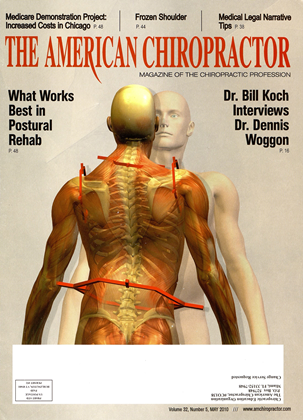Co-founder and CEO, Activator Methods International ¦ I rixrntly ai ii:ndi:d him Association oi Chiropractic Colleges' an- NIA1. RlSRAKCII AciRNFJA CoNFF.RRNCF. (RAC) in Las Vixjas. The conference, which focused on the relationship between chiropractic and public health in the 21st century, attracted a multi-disciplinary collection of healthcare professionals coming together to explore the latest research findings. While at the conference and appreciating the broad array of expertise in the audience. I remembered a time when I passed judgment on chiropractic physicians like Dr. Scott Haldeman, Dr. Bill Meeker and Dr. Bob Mootz. Years ago. 1 thought they were absolute traitors for attending multidisciplinary conferences like RAC, and now I'm grateful to them for setting an important precedent. By pioneering involvement and interaction among all healthcare professionals, those doctors helped open doors for all of us. Today, participating in conferences like RAC continues to be a key method for expanding knowledge, by exposing ourselves to the experiences of academic and medical professionals and helping those same professionals better understand the value of chiropractic. While 1 am pleased with the progress we have made, some of the presentations at RAC demonstrated that we still have a long way to go to fully integrate chiropractic into the mainstream healthcare landscape. In one of the presentations, an allopathic physician touched on how to categorize someone experiencing low back pain. He identified two categories—acute back pain and chronic back pain—and. from what I could ascertain, acute was considered intermittent, and chronic was viewed as a state of mind. His assessments admittedly frustrated me. I felt compelled to ask. "Have you ever heard of an adjustment?!" I've witnessed first hand through my own work with the Veteran Administration's Medical Center in Phoenix how many patients have been helped by chiropractic adjustments. who once thought their pain was psychological. But it's in environments like RAC where we can discover the continuing misperceptions and take steps to correct them, and that's what makes the collaborative environment so powerful. Among the many findings presented during the conference, one of the most notable hailed from presenter Dr. Georges C. Benjamin, MD, FACP, FACEP(E), executive director of the American Public Health Association, who shared valuable data on the factors causing premature death: 50 percent of premature deaths are attributed to individual behaviors, 20 percent to genetics, 20 percent to the environment, and 10 percent to inadequate healthcare. With chiropractic's emphasis on sustaining wellness through our own choices and behaviors, these statistics were particularly valuable to our profession. As chiropractic physicians, we have data to show that our own behaviors can influence our long-term prospects for health, and the decisions we make now do make a difference in the long run. Each year that I've attended RAC, I'm reminded of the significant work that we are doing as a profession. I have also been able to track where we have gained acceptance and what work still needs to be done. And I hope my colleagues will continue to join me on our mission to make chiropractic a central part of healthcare, both domestically and overseas. We know the value of our treatments, but we must continue to embrace multidisciplinary environments and network with all healthcare professionals to aid them in understanding the true benefits we can deliver to patients everywhere. Dr. Fulir travels extensively to ehiroprcielic seminars, conferences and events around the world. He will be providing his insights and perspectives from these visits as a regular guest commentator lor The American Chiropractor. I While I am pleased with the progress we have made, some of the presentations at RAC demonstrated that we still have a long way to go to fully integrate chiropractic into the mainstream healthcare landscape.
 View Full Issue
View Full Issue






